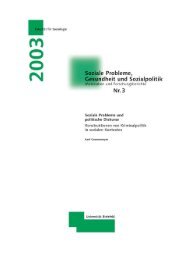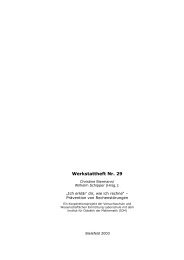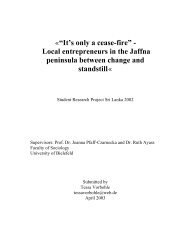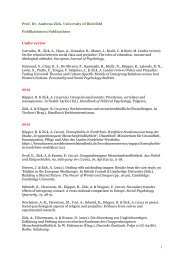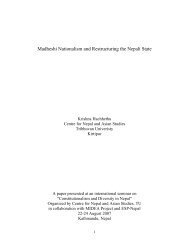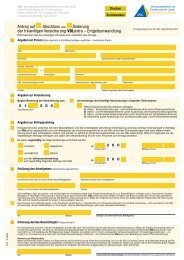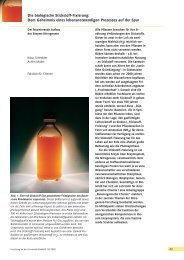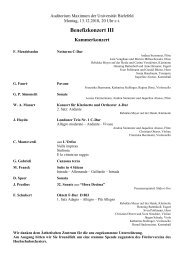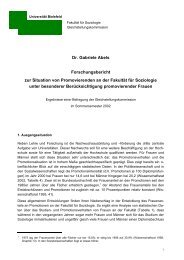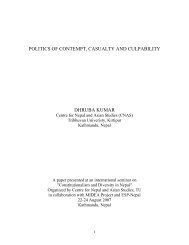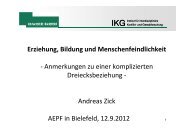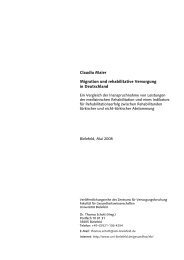Caste, Ethnicity and Inequality in Nepal
Caste, Ethnicity and Inequality in Nepal
Caste, Ethnicity and Inequality in Nepal
Create successful ePaper yourself
Turn your PDF publications into a flip-book with our unique Google optimized e-Paper software.
<strong>Nepal</strong>: Towards a Democratic Republic<br />
<strong>Caste</strong>, <strong>Ethnicity</strong> <strong>and</strong><br />
<strong>Inequality</strong> <strong>in</strong> <strong>Nepal</strong><br />
<strong>Nepal</strong> faces the danger of an all-out ethnic war break<strong>in</strong>g out<br />
<strong>in</strong> the Tarai between madhesis <strong>and</strong> parbatiyas. But, <strong>in</strong> most of<br />
the country there are so many complex <strong>and</strong> crosscutt<strong>in</strong>g<br />
ethnic allegiances which make a Sri Lankan-type polarisation<br />
unlikely. In the eastern Tarai, however, with its 30 per cent<br />
population of parbatiyas, there is a very real possibility that<br />
“two majorities with m<strong>in</strong>ority complexes” could confront<br />
each other <strong>in</strong> bloody vendettas.<br />
DAVID N GELLNER<br />
In Delhi it is possible to meet people<br />
who claim that they simply do not<br />
know what their caste is. Their parents<br />
never told them <strong>and</strong> they never asked. This<br />
is unimag<strong>in</strong>able <strong>in</strong> <strong>Nepal</strong>. In <strong>Nepal</strong>, as<br />
nearly everywhere <strong>in</strong> India, everyone knows<br />
what caste or ethnic group they belong to.<br />
Of course, some people may be attempt<strong>in</strong>g<br />
to pass as higher caste; successful, collective,<br />
upward mobility has happened <strong>in</strong> the<br />
past. And there are a few nationalist<br />
<strong>Nepal</strong>is who have adopted non-caste surnames<br />
(<strong>in</strong>clud<strong>in</strong>g “<strong>Nepal</strong>i”). But these<br />
m<strong>in</strong>or exceptions apart, it is a largely takenfor-granted<br />
fact of life that everyone has<br />
a caste or ethnic identity. Not only do<br />
people themselves always know what<br />
their own ascribed identity is supposed<br />
to be, others usually know too, simply<br />
from their surname. If the surname is not<br />
a sure-fire <strong>in</strong>dicator, it is usually possible<br />
to make a shrewd guess with a fair chance<br />
of success.<br />
None the less, <strong>in</strong> the officially correct<br />
sphere, caste has not been a respectable<br />
source of identity for quite some time. A<br />
shared national identity was supposed to<br />
def<strong>in</strong>e all <strong>Nepal</strong>is until 1990. But the k<strong>in</strong>d<br />
of national identity that was propagated <strong>in</strong><br />
schools <strong>and</strong> through government organisations<br />
was experienced as highly exclusionary<br />
by lower castes, by ethnic groups<br />
(janajatis), by religious m<strong>in</strong>orities (Buddhists,<br />
Muslims, <strong>and</strong> <strong>in</strong>creas<strong>in</strong>gly now by<br />
Christians), <strong>and</strong> by people of Indian<br />
ethnicity (madhesis) liv<strong>in</strong>g <strong>in</strong> the<br />
economically crucial Tarai region <strong>in</strong> the<br />
south of the country. If the period 1960<br />
to 1990 was one of nation-build<strong>in</strong>g, the<br />
17 years s<strong>in</strong>ce then has been a time of<br />
ethnicity-build<strong>in</strong>g. New identities have<br />
been forged, new organisations set up, <strong>and</strong><br />
new claims made; everyth<strong>in</strong>g is still <strong>in</strong> a<br />
state of considerable flux.<br />
Weight of the Past<br />
In the 19th century <strong>and</strong> well <strong>in</strong>to the<br />
1980s wealth was primarily measured <strong>in</strong><br />
l<strong>and</strong>. Those groups which held large tracts<br />
of l<strong>and</strong> were powerful, those who never<br />
held much l<strong>and</strong> (dalits) were dependent on<br />
others, <strong>and</strong> those who tended to lose l<strong>and</strong><br />
or had not enough to survive (frequently<br />
the janajatis, but many chetris <strong>and</strong> bahuns<br />
were among them) had to leave <strong>and</strong> look<br />
for work <strong>and</strong> l<strong>and</strong> further east <strong>in</strong> the<br />
Himalayas, with many end<strong>in</strong>g up <strong>in</strong><br />
Darjeel<strong>in</strong>g, Sikkim, Bhutan, <strong>and</strong> the northeast<br />
of India. Many jo<strong>in</strong>ed the gurkhas <strong>and</strong><br />
used their pensions to <strong>in</strong>vest <strong>in</strong> l<strong>and</strong> <strong>in</strong> their<br />
home village. Today <strong>Nepal</strong>i migrants head<br />
<strong>in</strong>to Indian cities, to the Gulf, to south-east<br />
Asia, <strong>and</strong> east Asia. There are supposed<br />
to be half a million <strong>in</strong> the Gulf <strong>and</strong> another<br />
half a million <strong>in</strong> the developed economies<br />
of the north. Comb<strong>in</strong>ed remittances are<br />
worth around a billion dollars a year,<br />
someth<strong>in</strong>g <strong>in</strong> the region of 12 per cent of<br />
gross domestic product. Retired soldiers<br />
<strong>and</strong> workers often no longer retire to their<br />
villages, however. If they return to <strong>Nepal</strong><br />
at all, they are more likely to settle <strong>in</strong><br />
Kathm<strong>and</strong>u, Pokhara or Biratnagar.<br />
Villages are places to visit with your children,<br />
but not to settle <strong>in</strong>.<br />
Dur<strong>in</strong>g the autocratic Rana regime (1846-<br />
1951) society was ordered accord<strong>in</strong>g to<br />
orthodox H<strong>in</strong>du notions. The national legal<br />
code of 1854, the Mulukhi A<strong>in</strong>, explicitly<br />
attempted to apply the ‘dharmasastras’ to<br />
the civil <strong>and</strong> crim<strong>in</strong>al law of the heterogeneous<br />
k<strong>in</strong>gdom [Höfer 1979]. All<br />
groups were equally called jat. The<br />
key dist<strong>in</strong>ctions, supported by law <strong>and</strong> the<br />
judicial system, were between the wearers<br />
of the sacred thread, the Tagadhari, on the<br />
one side, who were the elite of the society,<br />
<strong>and</strong> the rest, known as the Matwali, or<br />
alcohol-consum<strong>in</strong>g classes. The subord<strong>in</strong>ated<br />
groups were themselves divided <strong>in</strong>to<br />
enslaveable <strong>and</strong> non-enslaveable categories,<br />
<strong>and</strong> <strong>in</strong>to “clean” castes <strong>and</strong> “untouchables”.<br />
All the present-day “tribal” m<strong>in</strong>orities<br />
were <strong>in</strong> the Matwali, but clean, category.<br />
Some were enslaveable <strong>and</strong> others<br />
were not. Some were able to w<strong>in</strong> promotion<br />
to the non-enslaveable category if<br />
their elites were sufficiently well connected.<br />
It was a gradual process, some Matwalis<br />
achiev<strong>in</strong>g non-enslaveable status (<strong>and</strong> the<br />
legal right to be recruited <strong>in</strong>to the army)<br />
earlier than others.<br />
The dom<strong>in</strong>ant groups who spread<br />
throughout the country as l<strong>and</strong>owners,<br />
priests, adm<strong>in</strong>istrators, soldiers, <strong>and</strong> policemen,<br />
were the bahun (brahman) <strong>and</strong><br />
chetri (kshatriya) castes. With them went<br />
associated low castes, pr<strong>in</strong>cipally kami<br />
(blacksmiths), sarki (leather workers), <strong>and</strong><br />
damai (tailors). Together these groups are<br />
called parbatiyas (hill people) or pahadis.<br />
(Some refer to them as Indo-<strong>Nepal</strong>ese.)<br />
This was a simple but effective caste system<br />
<strong>and</strong> the tribal groups were slotted <strong>in</strong>to the<br />
middle, below the chetris, but above the<br />
“untouchable” artisans. One way <strong>in</strong> which<br />
the dom<strong>in</strong>ant group spread so successfully<br />
was through <strong>in</strong>termarriage. The offspr<strong>in</strong>g<br />
of chetri men <strong>and</strong> tribal women were accepted<br />
as chetris, though of lower status,<br />
<strong>and</strong> after a number of generations of strategic<br />
alliances could even achieve a more<br />
respectable full chetri status. The offspr<strong>in</strong>g<br />
of bahun fathers <strong>and</strong> tribal mothers also<br />
became chetris, <strong>in</strong> a strik<strong>in</strong>g departure from<br />
the biologically determ<strong>in</strong>ed identity logic<br />
of modern times. It is no surprise then that<br />
the chetris, the broad <strong>and</strong> dom<strong>in</strong>ant category<br />
to which the k<strong>in</strong>gly thakuri sub-caste<br />
Economic <strong>and</strong> Political Weekly May 19, 2007 1823
elongs, is the largest s<strong>in</strong>gle group <strong>in</strong> the<br />
country as a whole <strong>and</strong> is found everywhere<br />
from west to east.<br />
Accommodat<strong>in</strong>g the newars, the <strong>in</strong>digenous<br />
<strong>in</strong>habitants of the Kathm<strong>and</strong>u valley,<br />
with<strong>in</strong> the overall hill caste hierarchy<br />
was more problematic, because they possessed<br />
their own, more complicated, caste<br />
system, with about 20 castes, similar to<br />
those found <strong>in</strong> north India. The solution<br />
was to split the hierarchy <strong>and</strong> distribute the<br />
castes roughly where their ritual status<br />
warranted. In the same way, <strong>and</strong> even more<br />
so, the madhesi world of the Tarai rema<strong>in</strong>ed<br />
apart from this hill synthesis, more<br />
attuned to the culture <strong>and</strong> language of<br />
those they <strong>in</strong>termarried with on the other<br />
side of the border with India.<br />
From 1960 (strictly, from 1962, when the<br />
new constitution was promulgated) until<br />
1990 <strong>Nepal</strong> was ruled by a system known as<br />
partyless panchayat democracy [Whelpton<br />
2005]. Instituted by the present k<strong>in</strong>g’s<br />
father, k<strong>in</strong>g Mahendra, it was supposed to<br />
be more “suited to the soil of <strong>Nepal</strong>”, <strong>and</strong><br />
was designed to mobilise the country’s<br />
various groups for the “all-round development”<br />
of the country. Ethnic <strong>and</strong> caste affiliations<br />
were discouraged, <strong>in</strong> the name of<br />
patriotism <strong>and</strong> nation-build<strong>in</strong>g. Organisations<br />
could be formed for cultural purposes,<br />
but not <strong>in</strong> order to advance the cause of<br />
particular social or regional <strong>in</strong>terests politically.<br />
All political parties were banned.<br />
With no reservations as <strong>in</strong> India, nor<br />
even any development <strong>in</strong>itiatives specifically<br />
target<strong>in</strong>g “backward” groups, the<br />
lion’s share of the fruits of development<br />
<strong>and</strong> rapidly exp<strong>and</strong><strong>in</strong>g educational opportunities<br />
<strong>and</strong> rewards went to those groups<br />
who were already well connected <strong>and</strong> had<br />
long established traditions of literacy <strong>and</strong><br />
academic study, namely, bahuns, some<br />
chetris, <strong>and</strong> some (pr<strong>in</strong>cipally high-caste)<br />
newars (BCNs). On the rare occasions when<br />
figures were collected on the proportion<br />
of BCNs <strong>in</strong> high education or the professions,<br />
they were considered too explosive<br />
to publish. People were told there was no<br />
ethnicity <strong>in</strong> <strong>Nepal</strong>. Gopal Gurung wrote<br />
a book about it under the panchayat regime,<br />
call<strong>in</strong>g it Hidden Facts <strong>in</strong> <strong>Nepal</strong>i<br />
Politics. He was put <strong>in</strong> prison for it <strong>in</strong> 1988<br />
<strong>and</strong> after 1990 started the Mongol National<br />
Organisation, which won a base <strong>in</strong><br />
local government <strong>in</strong> east <strong>Nepal</strong>.<br />
The situation <strong>in</strong> the Tarai dur<strong>in</strong>g this<br />
period began to develop <strong>in</strong> ways which<br />
would store up trouble for the future. In<br />
the 19th century there were some areas of<br />
ancient settlement, as around Janakpur,<br />
1824<br />
but most of the Tarai region was covered<br />
with jungle <strong>and</strong> was sparsely populated by<br />
the tharus <strong>and</strong> other tribals who had some<br />
degree of <strong>in</strong>herited immunity to malaria.<br />
The British colonialists had allowed the<br />
<strong>Nepal</strong>ese state to reta<strong>in</strong> this strip of territory<br />
<strong>in</strong> order to ensure <strong>Nepal</strong> was economically<br />
viable, <strong>and</strong> <strong>in</strong>deed two districts<br />
<strong>in</strong> the far west, Kanchanpur <strong>and</strong> Kailali,<br />
were returned to <strong>Nepal</strong>’s rulers for their<br />
loyalty after 1857. Be<strong>in</strong>g flat <strong>and</strong> warm,<br />
the l<strong>and</strong> was much more fertile than the<br />
hills. The Ranas <strong>in</strong> the 19th century were<br />
concerned only with exp<strong>and</strong><strong>in</strong>g their<br />
revenue base, <strong>and</strong> were not at all <strong>in</strong>terested<br />
<strong>in</strong> what language their tenants spoke. They<br />
encouraged settlers to move <strong>in</strong> from further<br />
south with five- <strong>and</strong> 10-year tax breaks.<br />
In the 1950s <strong>and</strong> 1960s a programme of<br />
malaria eradication meant that the Tarai<br />
region became much more hospitable for<br />
people from the hills. Many who owned<br />
l<strong>and</strong> already, but visited the Tarai only <strong>in</strong><br />
the cold season, now settled there for good.<br />
Many others sold their l<strong>and</strong> <strong>in</strong> the hills <strong>and</strong><br />
moved south to the more agriculturally<br />
attractive flat l<strong>and</strong>. Often they moved <strong>in</strong>to<br />
areas where tribals had practised shift<strong>in</strong>g<br />
cultivation <strong>and</strong> over a matter of decades<br />
they were able to acquire the tribals’ l<strong>and</strong>,<br />
thanks to tribal <strong>in</strong>nocence <strong>in</strong> matters of<br />
moneylend<strong>in</strong>g, l<strong>and</strong> deeds, <strong>and</strong> deal<strong>in</strong>g<br />
with state officials. In some cases whole<br />
villages of tharus moved further on, to the<br />
far west Tarai of <strong>Nepal</strong>, for example, where<br />
there was still virg<strong>in</strong> forest.<br />
For the non-tribal (caste-organised)<br />
people who have lived <strong>in</strong> the Tarai for<br />
generations, <strong>and</strong> are called madhesis, there<br />
are cultural, k<strong>in</strong>, educational, <strong>and</strong> political<br />
l<strong>in</strong>ks with Uttar Pradesh <strong>and</strong> Bihar. The<br />
border with India is therefore a border that<br />
is, for many purposes, merely notional.<br />
Many of <strong>Nepal</strong>’s madhesis take their wives<br />
from India, <strong>and</strong> marry their daughters there<br />
<strong>in</strong> return. Many study there, shop there,<br />
<strong>and</strong> move to <strong>and</strong> fro frequently. <strong>Nepal</strong>i <strong>and</strong><br />
Indian citizens may move <strong>and</strong> work across<br />
the border without let or h<strong>in</strong>drance. This<br />
makes the <strong>Nepal</strong>-India border fundamentally<br />
different to India’s borders with any<br />
of its other neighbours. It means that <strong>Nepal</strong><br />
cannot, <strong>in</strong> truth, carry out any economic<br />
policy that is different from India’s, because<br />
goods will simply flow across the<br />
border <strong>in</strong> whichever is the economically<br />
advantageous direction. The current <strong>Nepal</strong><br />
government’s suicidal policy of not<br />
rais<strong>in</strong>g petrol <strong>and</strong> kerosene prices means<br />
that <strong>Nepal</strong>ese subsidised petroleum products<br />
are smuggled on a huge scale from<br />
<strong>Nepal</strong> <strong>in</strong>to India at enormous daily cost to<br />
the <strong>Nepal</strong>ese exchequer.<br />
<strong>Nepal</strong> is a nation forged <strong>in</strong> migration:<br />
migration of people from west to east<br />
through the Himalayas, as well as from<br />
south (the pla<strong>in</strong>s) to north (the hills), from<br />
north to south (to settle the pla<strong>in</strong>s), <strong>and</strong><br />
even (as <strong>in</strong> the tharus flee<strong>in</strong>g l<strong>and</strong> appropriation)<br />
from east to west. As noted already,<br />
many <strong>Nepal</strong>is did not stop at the<br />
borders of <strong>Nepal</strong>, but migrated further east<br />
to Darjeel<strong>in</strong>g, Bhutan, Assam, Burma, <strong>and</strong><br />
beyond. Some have returned, will<strong>in</strong>gly or<br />
unwill<strong>in</strong>gly, <strong>and</strong> settled <strong>in</strong> the Tarai. Others,<br />
born <strong>and</strong> bred <strong>in</strong> Darjeel<strong>in</strong>g, <strong>and</strong> therefore<br />
educationally more advanced than homegrown<br />
<strong>Nepal</strong>is, migrated to Kathm<strong>and</strong>u to<br />
man <strong>Nepal</strong>’s nascent private sector <strong>in</strong> the<br />
1970s <strong>and</strong> 1980s. Trade, labour migration,<br />
<strong>and</strong> l<strong>and</strong> shortage <strong>and</strong> the need to work,<br />
<strong>and</strong> now the availability of education<br />
<strong>and</strong> opportunity all over the globe, have<br />
ensured that <strong>Nepal</strong>is keep mov<strong>in</strong>g.<br />
Growth of the Janajati Movement<br />
In 1990 the panchayat system was overthrown<br />
by what has come to be called “the<br />
people’s movement” (‘jan <strong>and</strong>olan’). There<br />
Table 1: Population Breakdown of <strong>Nepal</strong> (2001 Census) (Total: 23.15 million)<br />
with Figures for Hill M<strong>in</strong>orities<br />
(Per cent)<br />
Parbatiyas Hill M<strong>in</strong>orities Language Loss Taraians Others<br />
(‘hill people’) (Janajatis) among M<strong>in</strong>orities (‘pla<strong>in</strong>s people’)<br />
Bahun 13 Magar 7.2 68 Tharu 6.7 Muslims 4.2<br />
Chetri (<strong>in</strong>cl thakuri) 18 Newar 5.5 34 Yadav 4<br />
Dalit 9 Tamang 5.6 11 (+ many small castes <strong>in</strong>cl<br />
dalits <strong>and</strong> janajatis)<br />
Rai 3 16<br />
Gurung 2.4 50<br />
Limbu 1.6 14.5<br />
Totals 40 25 30 5<br />
Notes: Dalit = former untouchables; janajatis, underl<strong>in</strong>ed, are ma<strong>in</strong>ly those who were formerly called hill<br />
tribes; 59 groups were officially designated as janajatis <strong>in</strong> February 2002, not all of which had<br />
been <strong>in</strong>cluded <strong>in</strong> the 2001 Census. Estimated figures for language loss are taken from Whelpton<br />
(1997, p 59). All figures are likely to be disputed.<br />
Economic <strong>and</strong> Political Weekly May 19, 2007
were street battles <strong>and</strong> demonstrations for<br />
several months with 41 official martyrs<br />
before k<strong>in</strong>g Birendra agreed to legalise<br />
political parties <strong>and</strong> allow a new constitution.<br />
The new constitution def<strong>in</strong>ed <strong>Nepal</strong><br />
as “a multi-ethnic, multil<strong>in</strong>gual, democratic,<br />
<strong>in</strong>dependent, <strong>in</strong>divisible, sovereign,<br />
H<strong>in</strong>du <strong>and</strong> Constitutional Monarchical<br />
K<strong>in</strong>gdom”. Ethnic <strong>and</strong> religious activists<br />
were very disappo<strong>in</strong>ted that the word<br />
“H<strong>in</strong>du” was still there; none the less, the<br />
addition of the words “multi-ethnic”, “multil<strong>in</strong>gual”<br />
<strong>and</strong> “constitutional” was a genu<strong>in</strong>ely<br />
new departure.<br />
The revolution of 1990 ushered <strong>in</strong> an<br />
entirely new situation, <strong>and</strong> fired the start<strong>in</strong>g<br />
gun, so to say, on a rapid <strong>and</strong> not wholly<br />
predictable process of ethnogenesis similar<br />
to what happened <strong>in</strong> India under the<br />
Raj <strong>and</strong> for rather similar reasons<br />
[Whelpton 1997; Pfaff-Czarnecka 1999;<br />
Gellner 2001]. Many people from m<strong>in</strong>ority<br />
backgrounds felt that a great weight had<br />
been removed from their shoulders, by the<br />
demise of the panchayat ideology claim<strong>in</strong>g<br />
that all <strong>Nepal</strong>is were the same while <strong>in</strong><br />
practice <strong>in</strong>stitutionalis<strong>in</strong>g parbatiya supremacy.<br />
Ethnic difference began to acquire<br />
<strong>in</strong>creas<strong>in</strong>g political salience, especially with<br />
the publication, for the first time <strong>in</strong> 1991,<br />
of data on caste <strong>and</strong> ethnic group affiliation.<br />
Hitherto hidden strengths <strong>and</strong> weaknesses<br />
were now revealed. Democracy,<br />
as all south Asians are aware, is a<br />
numbers game.<br />
<strong>Nepal</strong>is <strong>and</strong> their friends have had to<br />
learn a new word for “tribe” s<strong>in</strong>ce the<br />
beg<strong>in</strong>n<strong>in</strong>g of the 1990s, namely, janajati.<br />
The term seems to have come <strong>in</strong>to <strong>Nepal</strong>i<br />
from Bengali, via Darjeel<strong>in</strong>g. It was completely<br />
unknown <strong>in</strong> the early 1980s, started<br />
to be used <strong>in</strong> activist circles shortly before<br />
1990, <strong>and</strong> now has wide currency among<br />
the political elite, though it is still far from<br />
be<strong>in</strong>g universally recognised <strong>in</strong> the wider<br />
population. It picks out those groups previously<br />
known as “hill tribes” (plus the<br />
tharus <strong>and</strong> similar groups, e g, santals,<br />
from the Tarai). The dist<strong>in</strong>ction between<br />
caste <strong>and</strong> janajati thus corresponds more<br />
or less to the Indian dist<strong>in</strong>ction between<br />
caste <strong>and</strong> tribe – with the important proviso<br />
that <strong>in</strong> <strong>Nepal</strong> the janajatis comprise<br />
a much larger percentage of the population<br />
(the exact percentage is debated: some<br />
claim they are as much as 40 per cent or<br />
more of the overall population).<br />
Table 1 does not <strong>in</strong>clude the high Himalayan<br />
groups, as they represent such<br />
small numbers <strong>in</strong> the population as a whole<br />
(Table 2). These groups of Tibetan culture,<br />
religion, <strong>and</strong> language prefer – for strategic<br />
reasons – not to be called “Tibetan” (the<br />
<strong>Nepal</strong>i “Bhote” is often highly pejorative)<br />
but rather to form a large number of very<br />
small ethnic groups based on their particular<br />
valley or group of villages. These groups<br />
are also <strong>in</strong>cluded <strong>in</strong> the janajati category.<br />
Just as the second column of Table 1<br />
does not exhaust the janajati category, so<br />
column four, the Taraians, cannot be labelled<br />
‘madhesi’. The term ‘madhesi’ literally<br />
means a dweller <strong>in</strong> ‘madhes’ (‘madhyades’)<br />
or the pla<strong>in</strong>s. In theory anyone liv<strong>in</strong>g <strong>in</strong><br />
the Tarai could be considered a madhesi,<br />
but it has come to have an ethnic mean<strong>in</strong>g<br />
(just like parbatiya or pahade, mean<strong>in</strong>g<br />
“hill-dweller”). It refers to pla<strong>in</strong>s-dwellers<br />
of Indian, H<strong>in</strong>du orig<strong>in</strong>. Usages differ, but<br />
it seems clear that the tharus <strong>and</strong> other<br />
groups do not wish to be <strong>in</strong>cluded <strong>in</strong> the<br />
category. Parbatiyas who are settled <strong>in</strong> the<br />
pla<strong>in</strong>s are def<strong>in</strong>itely not <strong>in</strong>cluded, <strong>and</strong><br />
Muslims are also not full members either.<br />
Janajati Politics<br />
The janajati movement is driven, fundamentally,<br />
by anti-brahmanism <strong>and</strong> the<br />
overwhelm<strong>in</strong>g presence <strong>in</strong> public life of<br />
bahuns, revealed by the census to be only<br />
13 per cent of the population as a whole<br />
(the po<strong>in</strong>t can be made more acerbically<br />
by say<strong>in</strong>g that bahun men constitute only<br />
6.5 per cent of the population but lead all<br />
the major political parties, etc). Politics,<br />
the judiciary, the universities, <strong>and</strong> the civil<br />
service are all dom<strong>in</strong>ated by bahuns. One<br />
attempt to quantify this, looked at the<br />
leaders of the judiciary, civil service, trade<br />
unions, etc, <strong>and</strong> found that bahuns <strong>and</strong><br />
chetris together – just 31 per cent of the<br />
population – had two-thirds of the jobs,<br />
whereas hill janajatis (i e, exclud<strong>in</strong>g newars<br />
<strong>and</strong> tharus), with 22 per cent of the population<br />
had just 7 per cent of the jobs, <strong>and</strong><br />
madhesis, with 31 per cent of the population<br />
had only 11 per cent of the jobs.<br />
Dalits with nearly 9 per cent of the population<br />
had just 0.3 per cent of the jobs. 1<br />
Some janajati activists have attempted<br />
to build a national alliance around Buddhism,<br />
<strong>in</strong> order to oppose the presumed<br />
H<strong>in</strong>duism of the parbatiya high castes. The<br />
Buddhism they espouse bears a close<br />
resemblance to the engaged <strong>and</strong> politicised<br />
Buddhism of B R Ambedkar, though<br />
he is not an icon they <strong>in</strong>voke, because their<br />
constituency is not the dalits. The attempt<br />
to build a Buddhist coalition founders,<br />
however, on the fact that many janajatis<br />
have long <strong>and</strong> deep commitments to some<br />
form of sectarian H<strong>in</strong>duism, some have<br />
their own shamanic traditions, <strong>and</strong> many<br />
others have converted to Christianity.<br />
Statistics on representation <strong>in</strong> high positions<br />
should not be <strong>in</strong>terpreted to mean<br />
that all janajatis are equally deprived.<br />
Among most m<strong>in</strong>ority groups there were<br />
elite families hold<strong>in</strong>g l<strong>and</strong> or other resources<br />
<strong>and</strong> with connections to the state<br />
or even the palace, though more so<br />
among some ethnic groups than others.<br />
Some groups, notably the newars <strong>and</strong><br />
thakalis, have done well as traders<br />
<strong>and</strong> bus<strong>in</strong>essmen.<br />
On February 10, 2002, the m<strong>in</strong>istry of<br />
law, justice, <strong>and</strong> parliamentary affairs published<br />
an official list of 59 janajati groups<br />
(unlike <strong>in</strong> India, it is not called a<br />
schedule). 2 For those on the list, there will<br />
be reserved seats <strong>in</strong> political, adm<strong>in</strong>istrative,<br />
<strong>and</strong> educational <strong>in</strong>stitutions. In 1990<br />
a new national organisation, the <strong>Nepal</strong><br />
Janajati Adivasi Mahasangh or <strong>Nepal</strong><br />
Association of Indigenous Nationalities or<br />
NEFIN, was founded (though the term<br />
“<strong>in</strong>digenous” was added only later). In the<br />
beg<strong>in</strong>n<strong>in</strong>g there were just seven member<br />
organisations. Today, of the 59 officially<br />
recognised groups, nearly all now have an<br />
organisation which is their official representative<br />
with one vote <strong>in</strong> NEFIN.<br />
A few groups had an old (i e, pre-1990)<br />
national organisation. The oldest was the<br />
Tharus’ Kalyankar<strong>in</strong>i Sabha, founded <strong>in</strong><br />
1949 with antecedents as far back as 1922.<br />
In those days it was a l<strong>and</strong>lord-dom<strong>in</strong>ated<br />
caste-reform <strong>and</strong> sanskritis<strong>in</strong>g organisation,<br />
much <strong>in</strong>fluenced by caste associations<br />
<strong>in</strong> India. It has metamorphosed <strong>in</strong>to<br />
a modern <strong>in</strong>digenous pressure group. 3<br />
Most groups have formed a representative<br />
organisation only after 1990, <strong>and</strong> <strong>in</strong> the<br />
case of many smaller groups this has been<br />
directly encouraged <strong>and</strong> assisted by NEFIN.<br />
Under pressure from NEFIN, the government<br />
founded a unit called the <strong>Nepal</strong><br />
Foundation for Indigenous Nationalities<br />
(or NFDIN), which has the task of uplift<strong>in</strong>g<br />
janajatis. As such it operates under the<br />
m<strong>in</strong>istry of local development. Both NEFIN<br />
<strong>and</strong> NFDIN have been successful <strong>in</strong> attract<strong>in</strong>g<br />
large grants from the British<br />
Department for International Development<br />
(DFID). In attempt<strong>in</strong>g to deal with the<br />
question how reservations should be distributed<br />
between different janajatis, given<br />
that some are far more educationally <strong>and</strong><br />
economically advantaged than others<br />
(newars <strong>and</strong> thakalis <strong>in</strong> particular be<strong>in</strong>g<br />
two of the best-off groups <strong>in</strong> the country),<br />
NEFIN came up with the <strong>in</strong>genious<br />
Economic <strong>and</strong> Political Weekly May 19, 2007 1825
five-fold classification illustrated <strong>in</strong><br />
Table 2. The idea is that the reserved “seat”<br />
should only be released for one category<br />
if no c<strong>and</strong>idates from more disadvantaged<br />
categories of janajati come forward. Thus<br />
Newar <strong>and</strong> Thakali c<strong>and</strong>idates would only<br />
qualify for reserved seats <strong>in</strong> medic<strong>in</strong>e at the<br />
Maharajganj Teach<strong>in</strong>g Hospital, for <strong>in</strong>stance,<br />
if there were <strong>in</strong>sufficient Gurung, Magar,<br />
etc, c<strong>and</strong>idates to fill the available places.<br />
Maoists Play the Ethnic Card<br />
The Communist Party of <strong>Nepal</strong> (Maoist)<br />
[CPN(M)] launched its “People’s War”<br />
on February 12, 1996, with attacks on<br />
police stations <strong>in</strong> the districts of Rolpa,<br />
1826<br />
Rukum <strong>and</strong> S<strong>in</strong>dhuli, <strong>and</strong> on a agricultural<br />
development bank <strong>in</strong> Gorkha district. Rolpa<br />
<strong>and</strong> Rukum are adjacent districts <strong>in</strong> the<br />
west of the country, <strong>and</strong> the home of the<br />
kham magars.<br />
The <strong>Nepal</strong>ese Maoists had long been<br />
aware of ethnic difference <strong>and</strong> factored it<br />
<strong>in</strong>to their strategic calculations, much as<br />
Indian Naxalites have sought to establish<br />
bases <strong>in</strong> tribal areas. It was no co<strong>in</strong>cidence<br />
that the CPN(M) made the kham magar<br />
regions of Rolpa <strong>and</strong> Rukum districts their<br />
base area. These areas had been a target<br />
of leftist proselytisation from the 1950s<br />
onwards <strong>and</strong> the village of Thabang was<br />
known as a communist stronghold already<br />
<strong>in</strong> the panchayat days. As chairman<br />
Table 2: Classification of 59 Official Janajatis by NEFIN <strong>and</strong> NFDIN (2004)<br />
Prach<strong>and</strong>a expla<strong>in</strong>ed to leftist journalist<br />
Li Onesto <strong>in</strong> 1999, “And <strong>in</strong> western <strong>Nepal</strong><br />
there are the Mongolian ethnic groups –<br />
you saw how all our comrades there look<br />
Ch<strong>in</strong>ese. These nationalities are so s<strong>in</strong>cere<br />
<strong>and</strong> such brave fighters – historically they<br />
have had this k<strong>in</strong>d of culture. And upper<br />
caste chauv<strong>in</strong>ism <strong>and</strong> feudal ties do not<br />
prevail <strong>in</strong> these nationalities.” The magars<br />
are, <strong>in</strong> short, exemplary “primitive communists”<br />
who would enable the Maoists<br />
to br<strong>in</strong>g communism to the rest of <strong>Nepal</strong><br />
[cf Lecomte-Tilou<strong>in</strong>e 2004].<br />
In April 2002 the Maoists established a<br />
magar-dom<strong>in</strong>ated “special district” (‘bishes<br />
jilla’) <strong>in</strong> their heartl<strong>and</strong> <strong>in</strong> west <strong>Nepal</strong>. This<br />
led the way for the later declaration of<br />
Region Classification of Indigenous Nationalities<br />
Endangered Highly Marg<strong>in</strong>alised Marg<strong>in</strong>alised Disadvantaged Advantaged<br />
Mounta<strong>in</strong> (18) Shiyar (Chumba) Bhote (Bhotiya) Barhagaule (Bargaule) Thakali<br />
c 1,000 19,261 (0.08 per cent) c 2,000 12,973 (0.06 per cent)<br />
Sh<strong>in</strong>gsawa (Lhomi, Karbhote) Dolpo c 20,000 Byansi (Sauka, Byasi, Rang)<br />
c 2,000 Larke (Nupriba) 2,103 (0.01 per cent)<br />
Thudam c 200 c 4,000 Chairotan (Tamang Thakali,<br />
Lhopa (Mustang) Panchgaule) c 200<br />
c 5,000 Marphali Thakali<br />
Mugali (Mugu) (Puntan, Punel) c 2,000<br />
10-12,000 Sherpa 154,622 (0.68 per cent)<br />
Topkegola (Dhokpya) Tangbe (Tangbedani) c 400<br />
2-3,000 T<strong>in</strong>gaule Thakali<br />
Walung (Yhulkosompaimhi) c 1,500<br />
1,448 (0.01 per cent)<br />
Hill (24) Bankariya 44 Baramu 7,383 (0.03 per cent) Bhujel 117,568 Chantyal 9,814 (0.04 per cent) Newar<br />
Hayu 1,821 Chepang 52,237 (0.52 per cent) Gurung (Tamu) 543,571 1,245,232<br />
(0.01per cent) (0.23 per cent) Dura 5,169 (2.39 per cent) (5.48 per cent)<br />
Kusbadiya 552 Thami (Thangmi) (0.02 per cent) Jirel 5,316 (0.02 per cent)<br />
(0.00 per cent) 22,999 (0.10 per cent) Pahari 11,505 Limbu (Yakthung) 359,379<br />
Kusunda 162 (0.06 per cent) (1.58 per cent)<br />
(0.00 per cent) Phree (Free) Magar 1,622,421 (7.14 per cent)<br />
Lapcha (Lapcha, Sunuwar 95,254 Rai 635,151 (2.79 per cent)<br />
Rong) 3,660 (0.42 per cent) Yakkha (Dewan) 17,003<br />
(0.02 per cent) Tamang 1,282,304 (0.07 per cent)<br />
Surel 149 (5.64 per cent) Yolmo (Helambu) 579<br />
(0.00 per cent)<br />
Inner Tarai (7) Raji 2,399 Bote 7,969 Darai 14,859<br />
(0.01per cent) (0.04 per cent) (0.07 per cent)<br />
Raute 658 Danuwar 53,229 Kumal 99,389<br />
(0.00 per cent) (0.23 per cent) (0.44 per cent)<br />
Majhi (Bhumar)<br />
72,614 (0.32 per cent)<br />
Tarai (10) Kisan (Kuntum) Dhanuk (Rajbanshi, Dhimal 19,537<br />
2,876 (0.01 per cent) Khumu) (0.09 per cent)<br />
Meche (Bodo) 188,150 (0.83 per cent) Gangai 31,318<br />
3,763 (0.02 per cent) Dhungar/Ghangar/Jhangad/ (0.14 per cent)<br />
Dhangad 41,764 (0.18 per cent) Rajbanshi (Koch)<br />
Santhal (Satar) 97,241 (0.43 per cent)<br />
42,698 (0.19 per cent) Tajpuriya<br />
13,250 (0.06 per cent)<br />
Tharu<br />
1,533,879 (6.75 per cent)<br />
Total 10 12 20 15 2<br />
Note: There are now only five janajati groups without their organisation hold<strong>in</strong>g membership of NEFIN: Bankariya, Hayu, Kusunda, Raute, <strong>and</strong> Phree. Figures<br />
<strong>and</strong> percentages (which are the percentage of the total <strong>Nepal</strong>i population of 22,736,934) come courtesy of Sant Bahadur Gurung, director of NFDIN until<br />
2006; these follow the 2001 Census. Where there is no percentage this means that the group was not a category recognised by the 2001 Census; thus<br />
the figures are either unknown or are based on an estimate (note that <strong>in</strong> some cases, e g, Yolmo, the ethnic label is not widely recognised or accepted<br />
<strong>in</strong> the region, <strong>and</strong> therefore the figures are much lower than might be expected: thus while only 579 people returned ‘Yolmo’ as their ethnicity, 3,986 recorded<br />
that they spoke ‘Yolmo’).<br />
Sources: Adapted from NEFIN (2004) <strong>and</strong> nef<strong>in</strong>.org.np.<br />
Economic <strong>and</strong> Political Weekly May 19, 2007
autonomous regions <strong>in</strong> January <strong>and</strong> February<br />
2004. The entire country was divided<br />
<strong>in</strong>to n<strong>in</strong>e “autonomous” regions, which on<br />
paper were the first level of government<br />
below the national. Six of the n<strong>in</strong>e were<br />
named on an ethnic basis, <strong>and</strong> the unspoken<br />
assumption was that the leader of that<br />
region <strong>and</strong> the majority of the representatives<br />
<strong>in</strong> the regional government must<br />
come from the ethnic group so named,<br />
though no explicit statement to this effect<br />
is to be found <strong>in</strong> the Maoist rule book.<br />
The prom<strong>in</strong>ence which the Maoists have<br />
given to the ethnic issue has raised the<br />
question among commentators whether the<br />
Maoists genu<strong>in</strong>ely seek to address the<br />
grievances of ethnic activists, or whether<br />
they played the ethnic card because they<br />
knew they could outflank the political<br />
parties on this issue. They were well aware<br />
that the dom<strong>in</strong>ance of bahuns <strong>in</strong> all walks<br />
of public life did not lessen, <strong>and</strong> <strong>in</strong> some<br />
cases actually <strong>in</strong>tensified, after parliamentary<br />
multiparty democracy was re<strong>in</strong>troduced<br />
<strong>in</strong> 1990. The current unrest <strong>and</strong><br />
ethnic conflict <strong>in</strong> the <strong>Nepal</strong>ese Tarai would<br />
perhaps have been <strong>in</strong>evitable at some stage<br />
or other, but the role of the Maoists <strong>in</strong><br />
giv<strong>in</strong>g ethnic militancy a voice there has<br />
certa<strong>in</strong>ly been considerable.<br />
Mobilis<strong>in</strong>g for Power<br />
With the collapse of k<strong>in</strong>g Gyanendra’s<br />
attempt to re<strong>in</strong>state autocratic monarchical<br />
rule <strong>in</strong> April 2006 follow<strong>in</strong>g the “second<br />
people’s movement”, a new, <strong>and</strong> revolutionary<br />
situation has emerged. In November<br />
2006 the Seven-Party Alliance <strong>and</strong> the<br />
Maoists signed an agreement which would<br />
lead to an <strong>in</strong>terim constitution, an <strong>in</strong>terim<br />
parliament, <strong>and</strong> an <strong>in</strong>terim government to<br />
oversee the elections to a constituent assembly<br />
(CA). The arguments s<strong>in</strong>ce have<br />
been about the degree to which janajati<br />
dem<strong>and</strong>s for proportional representation<br />
<strong>in</strong> the CA should be met. At the same time,<br />
armed clashes of madhesis opposed to the<br />
Maoists, or split from the Maoists, have<br />
<strong>in</strong>tensified with the Maoists <strong>and</strong> with others<br />
<strong>in</strong> the Tarai. In the eastern Tarai ethnic<br />
cleans<strong>in</strong>g has been go<strong>in</strong>g on, with parbatiya<br />
households <strong>and</strong> civil servants be<strong>in</strong>g chased<br />
out. Elections to the CA, which were forcefully<br />
announced for June, have had to be<br />
postponed because the country simply is<br />
not ready: constituencies, voters’ lists, the<br />
exact method of ensur<strong>in</strong>g proportionality<br />
– none of this had been decided.<br />
How a newly decentralised state or a<br />
<strong>Nepal</strong> of federal republics would work is<br />
the matter of vociferous debate. (It is<br />
<strong>in</strong>terest<strong>in</strong>g <strong>in</strong> this connection that the<br />
Maoists have been very quiet about their<br />
autonomous ethnic republics s<strong>in</strong>ce around<br />
August 2006.) There are “homel<strong>and</strong>s”, i e,<br />
districts where the hill m<strong>in</strong>orities form a<br />
majority, or where madhesis form a<br />
majority, but there is also a very large<br />
degree of <strong>in</strong>termixture with people from<br />
many different groups liv<strong>in</strong>g together. In<br />
only 15 out of the 75 districts of <strong>Nepal</strong><br />
is there a s<strong>in</strong>gle group that makes up more<br />
than 50 per cent of the population.<br />
There are Tamangs, for example, to be<br />
found virtually all over the country, as well<br />
as <strong>in</strong> India. Normally migration means<br />
language loss, <strong>in</strong> two or more generations,<br />
which is why all <strong>Nepal</strong>is <strong>in</strong> Darjeel<strong>in</strong>g<br />
speak <strong>Nepal</strong>i <strong>and</strong> why Darjeel<strong>in</strong>g was one<br />
of the crucibles of <strong>Nepal</strong>i literature <strong>and</strong><br />
<strong>Nepal</strong>i national consciousness, even though<br />
the majority of Darjeel<strong>in</strong>gites are descended<br />
from migrants whose mother tongue was<br />
one of the m<strong>in</strong>ority languages. Despite this<br />
melt<strong>in</strong>g pot effect, one consequence of the<br />
Indian reservations system is that <strong>in</strong> recent<br />
years tribal <strong>and</strong> caste groups that long ago<br />
lost any cultural dist<strong>in</strong>ctiveness are now<br />
seek<strong>in</strong>g to re-establish it, sometimes by<br />
visit<strong>in</strong>g their “homel<strong>and</strong>” with<strong>in</strong> <strong>Nepal</strong> <strong>in</strong><br />
order to recover their cultural traditions<br />
[Shneiderman <strong>and</strong> Tur<strong>in</strong> 2006].<br />
In one sense all these groups have lived<br />
together, if not <strong>in</strong> harmony, at least without<br />
ethnic war break<strong>in</strong>g out for the vast majority<br />
of the time. But the <strong>in</strong>equalities of the caste<br />
system, the privileged access to the state <strong>and</strong><br />
its benefits that accrued to the parbatiyas,<br />
mean that there has long been simmer<strong>in</strong>g<br />
discontent among janajatis, madhesis, <strong>and</strong><br />
dalits that the dom<strong>in</strong>ant bahuns <strong>and</strong> chetris<br />
are hardly aware of <strong>and</strong> are ill-equipped<br />
to underst<strong>and</strong> or deal with.<br />
The madhesis are particularly bitter about<br />
the way they have been treated as a potentially<br />
disloyal fifth column with<strong>in</strong> <strong>Nepal</strong><br />
for so many years, about the facile way <strong>in</strong><br />
which <strong>Nepal</strong>ese nationalism has been built<br />
on the symbols of hill culture <strong>and</strong> antagonism<br />
to India, thus exclud<strong>in</strong>g them from<br />
full participation <strong>in</strong> the nation. The bureaucracy<br />
<strong>and</strong> the army are dom<strong>in</strong>ated by<br />
parbatiyas, <strong>and</strong> madhesis feel disrespected<br />
by both. For many years the <strong>Nepal</strong>i Congress<br />
has treated the Tarai as a vote bank without<br />
ever offer<strong>in</strong>g proportionate leadership<br />
positions to madhesis. Dur<strong>in</strong>g the 1990s<br />
the government set up commissions to deal<br />
with the <strong>in</strong>equalities faced by women, by<br />
janajatis, <strong>and</strong> by dalits, but no recognition<br />
was given to the exclusions faced by<br />
madhesis. One madhesi slogan which<br />
targeted this cultural <strong>in</strong>equality, dem<strong>and</strong>ed<br />
that both the ‘dhoti’ <strong>and</strong> the ‘topi’ (the<br />
hillman’s cap) should receive equal respect.<br />
The recent violence <strong>in</strong> the Tarai has been<br />
concentrated ma<strong>in</strong>ly <strong>in</strong> the eastern Tarai,<br />
where madhesis are concentrated. In the<br />
western Tarai there are more tharus <strong>and</strong><br />
fewer long-established areas of settlement.<br />
The Maoists recognised these historical<br />
<strong>and</strong> cultural differences when they designated<br />
the western Tarai as the autonomous<br />
republic of Tharuwan <strong>and</strong> the eastern Tarai<br />
as Madhes. Part of the violence has pitted<br />
armed madhesi groups (they are charged<br />
with be<strong>in</strong>g supplied <strong>and</strong> recruited <strong>in</strong> part<br />
from over the border, as well as with be<strong>in</strong>g<br />
supported by revanchists <strong>in</strong> the palace)<br />
aga<strong>in</strong>st the Maoists, who are identified by<br />
many <strong>in</strong> the Tarai with the hill people. The<br />
bottom l<strong>in</strong>e is that this is a time of political<br />
transition <strong>and</strong> of a virtually collapsed state.<br />
Everyth<strong>in</strong>g is be<strong>in</strong>g renegotiated <strong>and</strong> the<br />
people of the Tarai f<strong>in</strong>ally decided that<br />
they must act now <strong>and</strong> at last be heard at<br />
the centre.<br />
In all this one group – the most divided,<br />
excluded, <strong>and</strong> disadvantaged of all, i e, the<br />
dalits – is <strong>in</strong> danger of be<strong>in</strong>g forgotten. On<br />
all criteria, the dalits come out considerably<br />
worse off than any other group, though<br />
noticeably the Muslims come out on the<br />
human development <strong>in</strong>dices as pretty similar.<br />
Among the dalits, those <strong>in</strong> the Tarai<br />
are the poorest <strong>and</strong> most deprived of all.<br />
<strong>Nepal</strong> faces two ma<strong>in</strong> dangers. One is<br />
of a return to civil war between the Maoists<br />
on the one side <strong>and</strong> the army on the other,<br />
a cowed <strong>and</strong> frightened middle class be<strong>in</strong>g<br />
will<strong>in</strong>g to go along with an army-backed<br />
regime <strong>in</strong> return for peace <strong>and</strong> a semblance<br />
of order. The other is of all-out ethnic war<br />
break<strong>in</strong>g out <strong>in</strong> the Tarai between madhesis<br />
<strong>and</strong> parbatiyas. In most of <strong>Nepal</strong> there are<br />
so many complex <strong>and</strong> cross-cutt<strong>in</strong>g allegiances<br />
that a Sri Lankan-type polarisation<br />
is unlikely. In the eastern Tarai, however,<br />
with its 30 per cent population of parbatiyas,<br />
there is a very real possibility that two<br />
“majorities with m<strong>in</strong>ority complexes”<br />
could confront each other <strong>in</strong> bloody vendettas.<br />
The politicians <strong>in</strong> Kathm<strong>and</strong>u seem<br />
to take an age to decide <strong>and</strong> agree on<br />
anyth<strong>in</strong>g, but they have pulled back from<br />
the br<strong>in</strong>k before, <strong>and</strong> it is to be hoped<br />
that they cont<strong>in</strong>ue to pull off compromises<br />
<strong>and</strong> solutions, while keep<strong>in</strong>g the peace<br />
process mov<strong>in</strong>g forwards, over the next<br />
couple of years. EPW<br />
Email: david.gellner@anthro.ox.ac.uk<br />
Economic <strong>and</strong> Political Weekly May 19, 2007 1827
Notes<br />
[For helpful comments on an earlier draft, I would<br />
like to thank Joanna Pfaff-Czarnecka <strong>and</strong> John<br />
Whelpton.]<br />
1 See Neupane (2000: 82), Lawoti (2005: 104-05).<br />
2 An earlier, unofficial, list recognised 61<br />
“nationalities” of <strong>Nepal</strong>, but one group, the<br />
manangis, decided to merge with the Gurungs,<br />
three separately listed villages decided to merge<br />
<strong>and</strong> form a s<strong>in</strong>gle ethnic group, the T<strong>in</strong>gaunle,<br />
<strong>and</strong> the Yakkha achieved recognition as a<br />
separate group, mak<strong>in</strong>g 59 <strong>in</strong> all.<br />
3 On Tharu ethnicity, see Guneratne (2002) <strong>and</strong><br />
Krauskopff (2003).<br />
References<br />
Gellner, D N (2001): ‘From Group Rights to<br />
Individual Rights <strong>and</strong> Back: <strong>Nepal</strong>ese Struggles<br />
with Culture <strong>and</strong> Equality’ <strong>in</strong> J Cowan,<br />
M Dembour <strong>and</strong> R Wilson (eds), Culture <strong>and</strong><br />
the Anthropology of Rights, Cambridge<br />
University Press, Cambridge, pp 177-200.<br />
Gellner, D N, J Pfaff-Czarnecka <strong>and</strong> J Whelpton<br />
(eds) (1997): Nationalism <strong>and</strong> <strong>Ethnicity</strong> <strong>in</strong> a<br />
H<strong>in</strong>du K<strong>in</strong>gdom: The Politics of Culture <strong>in</strong><br />
Contemporary <strong>Nepal</strong>, Harwood, Amsterdam.<br />
Guneratne, A (2002): Many Tongues, One People:<br />
The Mak<strong>in</strong>g of Tharu Identity <strong>in</strong> <strong>Nepal</strong>, Cornell<br />
University Press, Ithaca <strong>and</strong> London.<br />
Höfer, A (1979): <strong>Caste</strong> Hierarchy <strong>and</strong> the State:<br />
A Study of the Mulukhi A<strong>in</strong> of 1854,<br />
Universitätsverlag Wagner, Innsbruck,<br />
Reissued 2004 by Himal Books, Lalitpur,<br />
<strong>Nepal</strong>.<br />
Krauskopff, G (2003): ‘An “Indigenous M<strong>in</strong>ority”<br />
<strong>in</strong> a Border Area: Tharu Ethnic Associations,<br />
NGOs, <strong>and</strong> the <strong>Nepal</strong>i State’ <strong>in</strong> D N Gellner<br />
(ed), Resistance <strong>and</strong> the State: <strong>Nepal</strong>ese<br />
Experiences, Social Science Press, Delhi,<br />
pp 199-243.<br />
Lawoti, M (2005): Towards a Democratic <strong>Nepal</strong>:<br />
Inclusive Political Institutions for a<br />
Multicultural Society, Sage, New Delhi.<br />
Lecomte-Tilou<strong>in</strong>e, M (2004): ‘Ethnic Dem<strong>and</strong>s<br />
with<strong>in</strong> Maoism: Questions of Magar Territorial<br />
Autonomy, Nationality <strong>and</strong> Class’ <strong>in</strong> M Hutt<br />
(ed), Himalayan ‘People’s War’: <strong>Nepal</strong>’s<br />
Maoist Rebellion, Hurst, London, pp 112-35.<br />
NEFIN (2004): ‘Classified Schedule of Indigenous<br />
Nationalities of <strong>Nepal</strong>’, prepared by the Janajati<br />
Classification Task Force <strong>and</strong> approved by the<br />
Federal Council of NEFIN, March 1.<br />
Neupane, G (2000): Nepâlko Jâtiya Prasna:<br />
Sâmâjik Banot ra Sâjhedâriko Sambhâvanâ,<br />
Centre for Development Studies, Kathm<strong>and</strong>u.<br />
Pfaff-Czarnecka, J (1999): ‘Debat<strong>in</strong>g the State of<br />
the Nation: Ethnicisation of Politics <strong>in</strong> <strong>Nepal</strong>:<br />
A Position Paper’ <strong>in</strong> J Pfaff-Czarnecka et al<br />
(eds), Ethnic Futures: The State <strong>and</strong> Identity<br />
Politics <strong>in</strong> Asia, Sage, New Delhi, pp 41-98.<br />
Shneiderman, S <strong>and</strong> M Tur<strong>in</strong> (2006): ‘Seek<strong>in</strong>g the<br />
Tribe: Ethno-Politics <strong>in</strong> Darjeel<strong>in</strong>g <strong>and</strong><br />
Sikkim’, Himal Southasian, March,<br />
www.himalmag.com/2006.<br />
Whelpton, J (1997): ‘Political Identity <strong>in</strong> <strong>Nepal</strong>:<br />
State, Nation, <strong>and</strong> Community’ <strong>in</strong> Gellner et al<br />
(eds), pp 39-78.<br />
Whelpton, J (2005): A History of <strong>Nepal</strong>, Cambridge<br />
University Press, Cambridge.<br />
1828<br />
Economic <strong>and</strong> Political Weekly May 19, 2007



